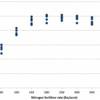Abstract
Fertilizer Experimentation, Data Analyses, and Interpretation for Developing Fertilization Recommendations: Examples with Vegetable Crop Research (SL345/SS548)
Fertilizer recommendations contain several important factors, including fertilizer form, source, application timing, placement, and irrigation management. Another important part of a fertilizer recommendation is the amount of a particular nutrient to apply. The optimum fertilizer amount is determined from extensive field experimentation conducted for several years, at multiple locations, with several varieties, etc. This 10-page fact sheet focuses on the research principles behind determining the optimum rate of fertilizer, including experimentation and interpreting research results for optimum crop production and quality in conjunction with minimal environmental consequences. Authors George Hochmuth, Ed Hanlon, and Allen Overman use examples from research with vegetable crops in Florida and emphasize that how one interprets the results is as important as how one conducts the research. Published by the UF Department of Soil and Water Science, October 2011.
The documents contained on this website are copyrighted by the University of Florida, Institute of Food and Agricultural Sciences (UF/IFAS) for the people of the State of Florida. UF/IFAS retains all rights under all conventions, but permits free reproduction by all agents and offices of the Cooperative Extension Service and the people of the State of Florida. Permission is granted to others to use these materials in part or in full for educational purposes, provided that full credit is given to the UF/IFAS, citing the publication, its source, and date of publication.

